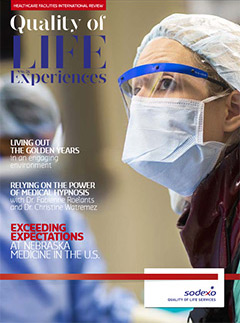How asset management enhances hospital life
Ask any movie director about the secrets of moviemaking, and they’ll mention the action behind the scenes. A hospital isn’t much different. Often unseen teams of people work hard to manage a wide range of assets that improve the Quality of Life of patients, visitors and healthcare professionals. Maximizing the efficiency and reliability of these resources is a major challenge for hospitals today.
In an environment of increasing demand and increasingly tight budgets, hospital mangers have two key concerns about their assets. One is maintenance: ensuring assets are safe and ready to use. The other concern is lifecycle management, replacing assets at the optimum time for cost and performance. Whether it’s power generation, air filtration, heating, electrical systems, water systems or medical equipment, everything needs to run smoothly and efficiently. Asset management experience makes it possible for Sodexo to deliver on both counts.

Smooth operations support continuous service
One of the largest hospital complexes in Europe, the Central Manchester University Hospital Foundation Trust is a good example of how this works. Sodexo manages over 500,000 assets, and provides 24/7 technical cover for five hospitals within the campus. Asset types range from patient care (hoists, dental chairs, specialist beds) to medical equipment (blood, drug and chemical fridges, fume cabinets, liquid nitrogen equipment) and building related assets (elevators, ventilation). Through rigorous risk assessment and an optimized maintenance strategy, it’s been possible to reduce the number of potential incidents threatening the continuity of service.
Minimized risks for maximum Quality of Life
All these measures are ultimately focused on one objective: improving the Quality of Life of patients, visitors and health care professionals. Chief among benefits for patients are consistent provision of quality. Clearly, this includes planned shutdowns of specific areas for maintenance and repairs. If equipment does fail, technically trained staff is on site, with supply chains ensuring best possible response times. Downtime is kept to a minimum by storing spares and equipment on the hospital premises. By checking that lights, power and oxygen systems are running smoothly, the risks – especially risks to life – are minimized. Meanwhile, the experience of patients and loved ones is improved by passages that are kept clear, floors that are clean and dry, doors that open and shut properly, and safe hospital equipment that works.
Making hospital management more efficient
Patients and their visitors aren’t the only ones who benefit from effective asset management. A well-maintained hospital is a positive working environment for health care professionals, improving their morale and well being. Staff is reassured when equipment is reliable and meets regulatory standards, and that there is a plan for its replacement or repair if it fails. All of this means that hospital teams can better focus on caring for and treating their patients.
A more efficient use of assets inevitably brings benefits to hospital managers. Key advantages are business continuity and an assurance that they can deliver on hospital policy and objectives. By reducing equipment failures and related costs they also gain greater operating efficiency. On a practical level, asset maintenance costs can then be budgeted with confidence. Through careful assessment and planning, it’s also possible to predict the optimum time to replace an asset. Accurate prediction of that investment point can save up to 20% of the asset’s total cost over its lifetime.
Health care provision is a complex task. For every decision, hospital managers must weigh up 3 key factors – cost, performance and risk. Effective asset management finds the right balance between all three.

/Building_Blocks/LOCAL/Multimedia/Images/img_header4.jpg)


